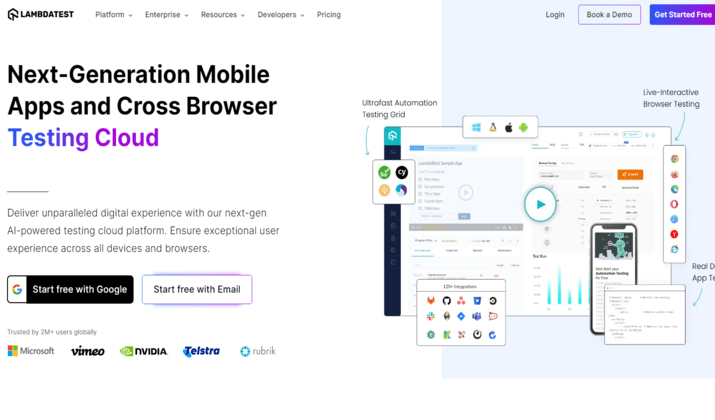Lambdatest is a highly sought-after software testing platform that offers a wide array of features and capabilities.
Many people choose Lambdatest for their software testing needs because of its robust automation solution and single cloud platform.
With Lambdatest, you can easily execute tests on their cloud-based platform, enabling efficient automation testing for your software.
This platform allows for comprehensive browser compatibility testing and performance monitoring across different browsers, ensuring that your software performs optimally in various environments.
Testsigma is a similar tool. It’s a comprehensive software testing platform that aims to simplify the testing process and make it more collaborative.
With its codeless testing feature, even non-technical users can easily create and execute tests without writing any code.
Testsigma also offers end-to-end testing capabilities, allowing you to test every aspect of your application from front-end to back-end.
This post is going to focus on these two platforms which will help you decide which is the better of the two tools for your testing needs.
Let’s get started without wasting any time.
Lambdatest vs Testsigma – Features & Benefits
Lambdatest
LambdaTest offers several key features that make it a valuable tool for developers and testers.
Here are some of the top features of LambdaTest.
- Real-Time Monitoring: LambdaTest provides real-time interactive cross-browser testing, allowing users to test their web apps across multiple combinations of browsers instantly.
- Testing / QA Management: The platform offers robust testing and quality assurance management tools, enabling users to efficiently manage their testing processes.
- Issue Tracking: LambdaTest includes features for tracking and managing issues encountered during testing, streamlining the debugging process.
- Testing Management: Users can effectively manage their testing processes, ensuring comprehensive coverage and efficient execution of tests.
- Move & Copy: LambdaTest allows users to move and copy their testing projects easily, enhancing workflow flexibility and organization.
- 24X7 Support: The platform offers round-the-clock support to assist users with any queries or issues they may encounter during testing.
- 3rd Party App Integration: LambdaTest integrates seamlessly with various third-party applications like Slack, Jira, Trello, and more, enhancing collaboration and workflow efficiency.
- Customized Reporting: Users can generate customized reports to track testing progress, results, and performance metrics, facilitating informed decision-making.
- Unlimited Smart UI Testing: LambdaTest provides smart UI testing capabilities, allowing users to conduct thorough and intelligent UI tests for their web applications.
- IP Whitelisting: The platform offers IP whitelisting features for enhanced security and access control during testing.
These features collectively make LambdaTest a comprehensive and user-friendly platform for cross-browser testing, automation, and quality assurance.
Testsigma
Testsigma, an AI-driven test automation software for web and mobile applications, offers a range of powerful features that set it apart in the testing landscape.
Here is what you get with Testsigma:
- Near-Zero Setup Time: Testsigma stands out by requiring near-zero initial setup time, cost, and ramp-up time, making it convenient and efficient for users to start their test automation processes quickly.
- Natural Language Test Automation: Users can write automated tests 5X faster using natural language, simplifying the test creation process and enhancing productivity.
- Cross-Browser/Device/OS Testing: Testsigma allows users to run tests on thousands of devices available on the cloud, ensuring comprehensive testing coverage across various browsers, devices, and operating systems.
- Dynamic Locator Strategy: The platform employs a dynamic locator strategy that saves maintenance time and effort by 70%, enhancing test stability and reducing maintenance overhead.
- AI-Driven Improvements: Testsigma leverages AI to suggest improvements in test plans, helping users include relevant or affected test cases efficiently.
- ROI Visibility: Users can see return on investment (ROI) right from the beginning with Testsigma, providing immediate insights into the benefits of using the platform.
- Integration Capabilities: Testsigma seamlessly integrates with various third-party applications like Slack, Jira, Jenkins, and CI/CD tools, enhancing collaboration and workflow efficiency.
- Parallel Test Execution: The platform supports parallel test execution, saving time and resources by allowing multiple tests to run simultaneously.
- 24×7 Support: Testsigma offers round-the-clock support, ensuring users have assistance whenever needed, enhancing the overall user experience and troubleshooting process.
- Comprehensive Testing Capabilities: Testsigma covers a wide range of testing aspects, including UI testing, cross-browser testing, mobile testing, regression testing, API testing, and more, providing a holistic testing solution for web and mobile applications.
By offering such powerful features, Testsigma comprehensively caters to the diverse needs of testers and developers, enabling efficient, reliable, and continuous testing processes for web and mobile applications.
Lambdatest vs Testsigma – Improvement Areas
Lambdatest and Testsigma, despite being great in their capacity, fall short in certain areas.
Let’s find out where they lack.
Lambdatest
From time to time, users have raised the following concerns about Lambdatest:
- High Test Execution Time: Some users report that LambdaTest has high test execution time, which could potentially impact testing efficiency and speed.
- Stability Issues with Simulators: Stability issues with simulators, indicating potential reliability concerns during testing processes is another concern raised by some.
- Significant Price Jump Between Subscriptions: Some users are not happy with a significant price jump between different subscription plans, which might affect the cost-effectiveness of using LambdaTest for budget users.
- Confusing UI for New Users: LambdaTest’s user interface was noted to be a little confusing for new users initially, although it becomes easier to navigate with time.
- Slow App Testing: Users have also highlighted that app testing on LambdaTest can be slow at times, which could impact the overall testing speed and efficiency.
LambdaTest could potentially focus on improving in these areas to enhance user experience and address usability and performance concerns.
Explore: LambdaTest vs Cypress
Testsigma
Similar to LambdaTest, even Testsigma has chinks in its armour. Take a look where it lacks:
- Reports Could Be Clearer: Some users are of the view that the reports generated by Testsigma could be clearer, potentially impacting the ease of understanding and interpreting test results.
- Lack of Full-Page Screenshot in Some Browsers: Another issue that has been highlighted over time is the lack of full-page screenshot functionality in some browsers, although it is possible to achieve this with custom functions, indicating a limitation in the default capabilities of Testsigma.
- Challenges with Test Case Hierarchy and Grouping: Testers also found it challenging to manage the hierarchy of test cases and group numerous test cases and test steps effectively, suggesting potential difficulties in organizing and structuring tests within the platform.
- Inconsistencies in Test Cases: A few users experienced difficulties in maintaining consistency in their test cases, partly due to the product’s limitations in accurately identifying elements and the complexity of the Document Object Model (DOM), although these issues were promptly resolved by the support team.
- Difficulty Identifying Correct HTML Elements: Users faced challenges in identifying the correct HTML elements, especially when nested within iframes, indicating potential issues with element identification in certain scenarios.
Testsigma must look into these issues and try to validate them. In order to retain user experience, it’s important to fix any and all issues to avoid a situation where customers start looking at alternative tools.
How to Pick the Best Testing Tool?
To choose a powerful testing tool, consider the following key factors:
1. Identify Testing Goals and Budget: Align the tools with your testing goals and budget to ensure that the quality of testing is not compromised. Adequately trained resources are essential for effective testing.
2. Collaboration Features: Assess the collaboration features of the tool to facilitate sharing test cases, results, and effective collaboration among team members.
3. Error Logging and Debugging: Choose tools that offer robust error logging and debugging features to quickly identify and resolve issues during the testing process.
4. Compatibility and Integration: Ensure that the testing tools are compatible with your web application’s programming languages, frameworks, libraries, and databases. Look for tools that seamlessly integrate with your development tools to avoid conflicts and delays in testing or development processes.
5. Security Features: Prioritize security and select a tool with strong features that protect applications and data, ensuring the security of your software.
6. Documentation and Support: Research the documentation and community support of the tool. Opt for tools with clear, accurate, and comprehensive reports, dashboards, and feedback that provide actionable insights and recommendations to improve your software’s quality and performance.
7. Automation Capabilities: Consider tools with robust automation features that enable efficient execution of test cases, accelerate testing cycles, and ensure consistent results.
By considering these factors, you can make an informed decision when selecting the best testing tool for your web and mobile software, ensuring effective testing, high-quality results, and a seamless user experience.
Conclusion
Lambdatest proves to be a top choice for automation testing, cross-browser testing, and performance monitoring. Though Testsigma also stands out with its unique features like codeless testing and end-to-end testing.
If you require robust automation capabilities and comprehensive browser compatibility testing, Lambdatest is an excellent option.
Alternatively, if you prefer a platform that simplifies the testing process and offers codeless testing, Testsigma may be the better fit.
Having said that, whether you choose Lambdatest or Testsigma, both platforms offer seamless solutions for your software testing needs.











